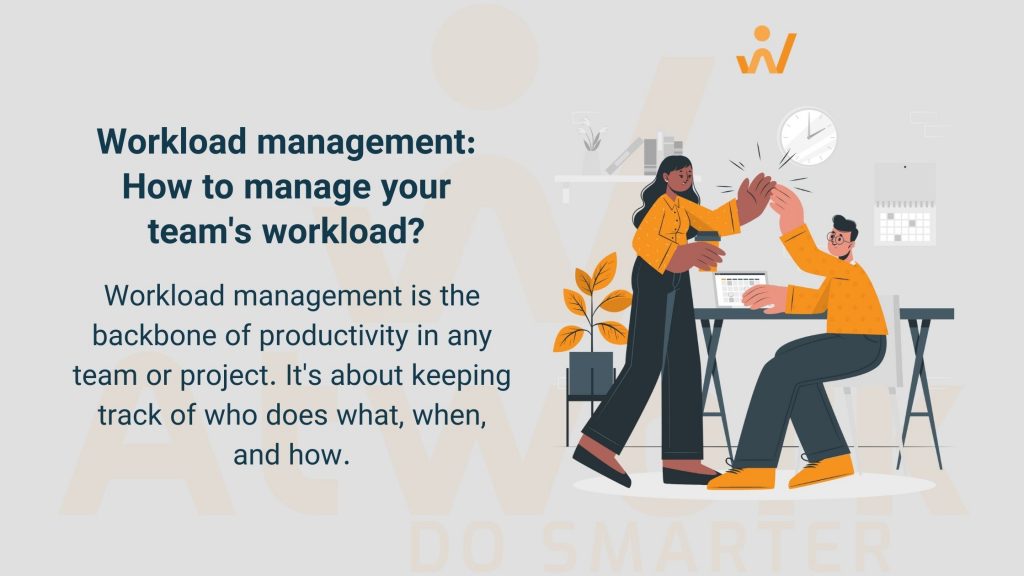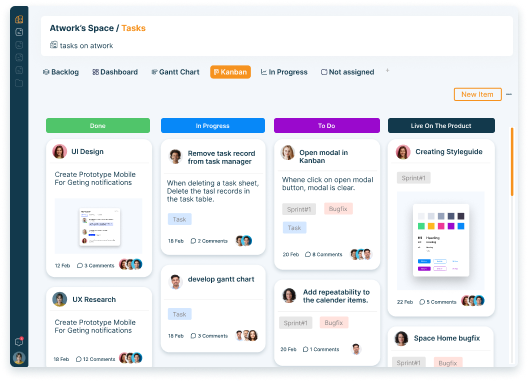Workload management: How to manage your team’s workload?

Workload management is the backbone of productivity in any team or project. It’s about keeping track of who does what, when, and how. Atwork Task Management offers a user-friendly platform to streamline this process, making it easier for teams to stay organized and focused.
In the world of teamwork, managing everyone’s tasks can be tough. But with the right tricks, it’s totally doable! In this guide, we’ll show you how to handle your team’s workload like a pro and make the most out of workload management techniques. Let’s dive in and make teamwork a breeze!
What are the strategies for managing workload?
 First of all if you like to know more about what is workload management please take a look at the link.
First of all if you like to know more about what is workload management please take a look at the link.
Strategies for managing workload include:
Task Prioritization:
Identify and prioritize tasks based on their importance and urgency to ensure that essential tasks are completed first.
Effective Delegation:
Delegate tasks to team members based on their skills, availability, and workload capacity, empowering them to take ownership and responsibility.
Realistic Deadline Setting:
Set achievable deadlines for tasks, considering factors such as complexity, resources, and dependencies, to prevent burnout and maintain quality.
Regular Team Meetings:
Schedule regular meetings to discuss progress, share updates, address challenges, and realign priorities, fostering collaboration and communication within the team.
Agile Methodologies:
Adopt agile practices such as iterative planning, continuous feedback, and adaptive responses to changes, enabling teams to respond quickly to evolving requirements and optimize workflow efficiency.
How To Make Sure Your Team’s Workload Is Divided Fairly
With these steps you could make sure workload is divided fairly:
Planning
Planning is important when you’re dividing tasks among your team. According to Morgenstern, you’re managing the energy and brainpower of everyone in the group. You can’t just squeeze it in between other tasks during your day. You need to set aside time for it. Morgenstern suggests spending one or two hours at the end of each week on “workflow management and review.” Think about what you want to achieve, who’s in your team, who’s good at what, and who needs to improve. These questions will help you decide how to assign tasks. Without a clear plan, Davey warns that managers often take the easy route and give the hard tasks to the most talented person. But then, nobody else learns how to do those tasks, and the team’s skills don’t grow.
Define responsibilities
Making sure everyone knows exactly what they’re supposed to do is crucial to your delegation plan. Each person in your team has a specific role, and the clearer they are about it, the easier it is for you to give out tasks, review them, and expect top-notch results. She suggests listing all the tasks that need doing and then assigning them based on each team member’s job, position, and strengths. This process also helps you spot any gaps in skills — “You might have 10 outfielders and no one at first base,” says Morgenstern. “Make a list of tasks that don’t fit any role and then figure out, with your team’s input, how to handle them.” You might need to temporarily give certain tasks to others or even hire someone new. Davey emphasizes the importance of being intentional when assigning tasks.
Establishing clear guidelines
Establishing clear expectations is a fundamental aspect of workload management. Consistently communicating the objectives you aim to achieve and underlining the level of dedication and involvement you expect helps streamline the team’s efforts. It’s crucial to continually reinforce the importance of each team member contributing their talents, skills, and energy.
It’s essential for everyone to understand that they should be actively participating and supporting each other. However, ensuring fairness and balance in workload distribution can be challenging because not all employees work at the same pace; what might take one person an hour could take another person all day. In essence, even when workloads are distributed evenly, they may not appear that way.
In effective workload management, it’s essential to communicate to your team that productivity is not solely determined by hours worked. Recognizing and praising strong performance openly, regardless of the hours put in. If someone like Jose consistently delivers excellent results, it’s important to publicly acknowledge their achievements. If there are complaints or gossip about someone’s hours, address it directly by emphasizing the importance of focusing on accomplishments and contributions rather than just the number of hours worked.
Engage in personal discussions
Engaging in one-on-one conversations with team members about their respective tasks within the workload is crucial for maintaining their motivation and commitment. You must set aside time for these personal meetings. “Being accessible is essential.” These discussions serve as opportunities to discuss professional goals, gain insights into team dynamics, and address any challenges. Here are some suggestions for topics to cover, using an Atwork task management approach and considering workload management.

Stay flexible
Remaining adaptable is crucial, as unforeseen projects can arise that instantly alter priorities, despite your best efforts in planning and regular communication with your team. Davey emphasizes the importance of flexibility while considering your interpretation of “fairness.” There are instances when fairness needs to be prioritized heavily in workload distribution. However, there are also situations where achieving a specific outcome within a tight timeframe takes precedence, leaving little room for fairness. In essence, despite your efforts to ensure an equitable workload, it may not always unfold as desired. It’s also vital to recognize that your team’s workload is dynamic. You’ll need to switch between different strategies based on the circumstances. Certain team members might need to put in extra hours on a project, while others may find it easier. However, this dynamic may change in the following quarter. The objective is to ensure that “over the course of the year, everything evens out.
Workload management tips
Make time to plan who does what.
Write down all the jobs and give them to people based on what they’re good at.
Encourage everyone to work hard and praise them when they do well, even if they don’t work long hours.
Don’t stick too strictly to your plan for who does what; when new projects come up and things change, be ready to adapt.
Don’t overwhelm your best worker. Before you give her even more to do, figure out which tasks can wait. Don’t avoid talking directly to an employee who’s not doing enough. Be clear about what you expect from them.
Workload management example
Have personal chats with your team members about how they’re handling their part of the workload. Ali everyone’s workload is fair, especially when it comes to managing the workload of his top achievers and hard workers. While these skilled employees often deserve the best tasks, Ali knows he shouldn’t overwhelm them and should give other team members a chance to grow. In a previous role leading a team at Reuters, Ali had a standout performer named Janice. When a big and interesting project came up, Ali initially thought of asking Janice to handle it. “I knew she was reliable and hardworking,” he says. But before making the request, Ali had an honest talk with Janice. “We discussed her current workload, and I encouraged her to check with clients and teammates to see if she could fit in this extra work,” he explains. Janice managed to take on the project, but Ali also helped her decide on other tasks strategically. “Sometimes, she would wait for better opportunities,” he says. “She was good at managing her workload, so I helped her weigh her options.”
Today, Janice leads corporate communications for a large consultancy in Europe. For another employee, Christina, things were different. “Christina was a good writer, but she didn’t like talking to clients, didn’t get along with teammates, and wasn’t interested in more responsibility.” Ali ‘s first step was to figure out why Christina wasn’t performing well. Was it confidence, skill, or interest? In a one-on-one chat, he got the answer. “It turned out she didn’t see herself in communications long-term,” he says. Together, they found tasks within her role that Christina could focus on to contribute more. “My aim as a manager is to give my team every chance to succeed, but if they don’t take it, it might be time for them to move on,” Ali concludes.
Atwork planform for workload management
Atwork platform for workload management helps you organize and oversee tasks efficiently. It provides a centralized space where you can assign tasks, track progress, and ensure that work is evenly distributed among team members. With this platform, you can easily mange tasks, set deadlines, and allocate resources based on each team member’s capacity and skills. Additionally, the platform allows for seamless communication and collaboration, enabling team members to stay informed and engaged throughout the project lifecycle. Overall, an Atwork planform for workload management streamlines processes, enhances productivity, and promotes effective teamwork.
If you want to get your Atwork freely just click on the registration button.